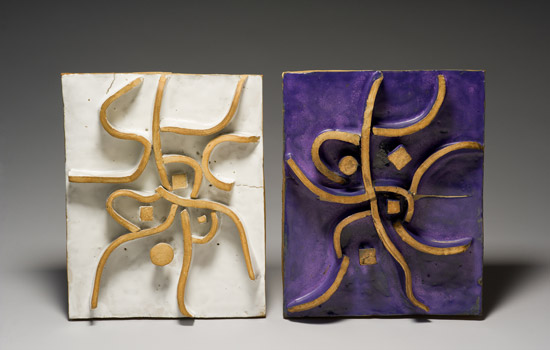Handcrafted Legacy: Frans Wildenhain Exhibition Debuts at RIT Aug. 20–Oct. 2
Mid-century ceramist, educator and innovator headlines cross-gallery showcase
A. Sue Weisler
Pottery by renowned ceramicist Frans Wildenhain, which will be on view during an exhibition from Aug. 20-Oct. 2 at RIT.
“You can do everything with clay,” said Frans Wildenhain in a 1979 interview with Robert Brown for the Archives of American Art, Smithsonian Institution.
“You can make a tree trunk. You can make an apple, which is smooth and round and full-blown and closed from the inside. There’s no recipe how to do this, and often I start out with no idea in my mind. It happens subconsciously.”
The renowned master Bauhaus potter often chose stoneware or earthenware as his medium and viewers will get a first-hand look at some of his utilitarian and sculptural pieces in the “Frans Wildenhain 1950-75: Creative and Commercial American Ceramics at Mid-Century” exhibition from Aug. 20 through Oct. 2. The show runs simultaneously at two venues on the Rochester Institute of Technology campus—Bevier Gallery and National Technical Institute for the Deaf’s Dyer Arts Center.
“In many significant ways, Frans Wildenhain's life, his art, his career and his work encapsulate virtues that are models for us all,” says Bruce Austin, RIT professor and organizer of the Wildenhain exhibit. “He was the consummate and complete artist, a business entrepreneur and innovator, and a mentor whose students today are internationally admired.”
Born in Leipzig, Germany, Wildenhain received his artistic training in the early 1920s at the Bauhaus pottery workshop in Weimar. He emigrated to the U.S. following World War II, settling at an artists’ commune at Pond Farm, north of San Francisco. The artist joined RIT in 1950 as a founding member of the School for American Craftsman, now the School for American Crafts. During his 20-year tenure, Wildenhain’s influence enriched the school’s curriculum and its students, as well as advanced global appreciation for the craft and art of ceramics.
In 2010, art collector Robert Bradley Johnson from Scottsville, N.Y., generously donated more than 300 pieces from his Wildenhain ceramic collection to the RIT Archives—half of which will be on view during the exhibition.
“Frans once told me, ‘You helped pay for the roof of my house,’ ” says Johnson, an ex-Kodak retiree who was “bitten by the collectors disease and couldn’t stop buying Wildenhain’s pots.”
With a gift earlier this year from Paul Rankin, the son of Wildenhain’s third wife, Lili Wildenhain, RIT Archives acquired four of his sketchbooks and artifacts from the 1970s, the last decade of his life, when Wildenhain made trips to Mexico, Florida and Europe. The exhibition will highlight some of this memorabilia collection in both galleries.
“Frans Wildenhain was an experimenter, always pushing forward as an educator and as an artist with his own body of work,” says RIT archivist Becky Simmons. “He traveled around the world and gathered ideas wherever he went. His sketchbooks are a visual note taking with drawings of landscapes, buildings, churches, people, flowers, plants, wildlife and animals.
“No one has ever done a retrospective on Wildenhain, to sit down and say, what time period did he really do these pots, and put them in order,” Simmons says. “It’s a wonderful opportunity to see the actual pieces and how the artist was thinking.”
The exhibition also features an accompanying catalogue, Frans Wildenhain 1950-75: Creative and Commercial American Ceramics at Mid-Century, which is comprised of scholarly essays, archival images and color photographs of the objects on display. The text includes Wildenhain’s biography, a history of RIT’s School for American Craftsmen, contextualization of Wildenhain’s art within mid-century modern U.S. ceramics, an investigation of the commercialization of crafts at Shop One, and an interview with collector Johnson.
The Wildenhain exhibit is a thematic extension of Austin’s previous exhibit, “The Arts & Crafts Movement in Western New York, 1900-1920.” Wildenhain advances the time frame, focusing on a single artist, to explore creative and commercial dimensions of artistic innovation.
For more information about the Frans Wildenhain exhibition, contact Austin at 585-475-2879










